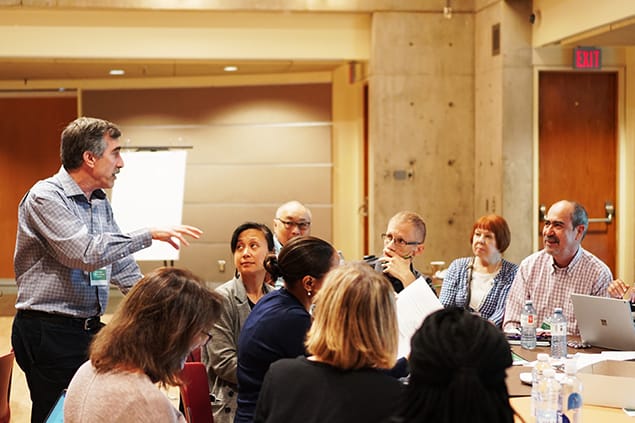In June WES Global Talent Bridge, its national partners, and the community cohorts in the Skilled Immigrant Integration Program (SIIP) participated in a working cross-border conference in Toronto. The delegates exchanged experiences and learned from each other and Canadian models, including mentorship programs, employer engagement, round table collaboration, and microlending.
Canadian participating partners included:
- Cities of Migration, a project of the Global Diversity Exchange (GDX) and Ryerson International at Ryerson University that showcases and promotes innovative practices in immigrant integration.
- Jumpstart Refugee Talent, a Canadian non-profit that supports refugees and newcomers in their entry into both the education and job markets.
- ACCES Employment, a non-profit, government funded employment agency that provides services in the Greater Toronto Area.
- Hire Immigrants, a hub for employer best practices in immigrant integration.
- Scadding Court Community Centre, a community centre in Toronto offering a number of programs and services.
- HealthForceOntario, the province’s initiative to ensure that Ontarians have access to the right number and mix of qualified health care providers.
- Government of New Brunswick, the provincial government of the province of New Brunswick, Canada.
- George Brown College, a public, fully accredited college of applied arts and technology with three full campuses in downtown Toronto.
- Windmill Microlending, a charity providing low-interest microloans to skilled immigrants to pay for licensing or training needed to restart a career in Canada.
Below are the ideas and Canadian models from the convening that resonated with the SIIP communities. Some of them are being adopted in the U.S. and others might be implemented in the future.
Microloans
The underemployment of immigrants costs Canada almost $13 billion annually according to the Conference Board of Canada. In the U.S. the low-skilled employment of college educated immigrants resulted in $39.4 billion in forgone wages and $3 billion in forgone state and local taxes.
One of the ways to address this problem is offering low-interest loans to skilled immigrants to reduce the financial barrier so they can obtain North American credentials and restart their career.
Last year, Louisville Forward partnered with Jewish Family Services and KentuckianaWorks and made up the Louisville cohort in the Skilled Immigration Integration Program. After connecting with Windmill Microlending in the SIIP convening in Toronto in 2018, Louisville is now developing its own micro-loan program. Both shared their experiences and progress with the 2019 cohort in a session on replicating best practices through SIIP technical assistance.
Unlike other financial institutions, Windmill provides loans to unemployed or underemployed immigrants who have little to no credit history in Canada, may have no assets to secure a loan and do not have a co-signer. Windmill also launched a unique refugee loan program with no interest paid at any time for those who gained convention status in Canada less than three years ago; the interest is paid by the generosity of community donors.
How has this best practice been replicated in the U.S.?
One of the identified areas of challenges in Louisville was funding gaps. The Office for Globalization at Louisville Forward used microlending in Canada as a leading example in North America due to a high success rate and now is progressing on a loan program to bridge funding gaps for skilled immigrant professionals. Last year, the Louisville SIIP cohort identified financial institutions who were willing to seed an initial pilot program and was working on securing an institutional partner to administer the loan funds. The goal is to create a sustainable model that will grow local capacity.
Mentorship and Networking Programs
Toronto Region Immigrant Employment Council (TRIEC) presented another Canadian model that helps advance immigrant integration and resonated with the U.S. communities. Jenny Okonkwo explained TRIEC’s Mentorship Program and Professional Immigrant Networks (PINs).
The Mentoring Partnership is an occupation specific program that connects established professionals with newcomer professionals. There are reasons why becoming an employer partner is crucial for many organizations that work with TRIEC: today they are looking to make their workplaces more inclusive and, recognizing that they don’t have those skills and expertise they need in the workforce. The program has impressive results: 77 percent of mentees are employed in their field at six months; 71 percent of mentors say they are more willing to hire an immigrant professional.
Since skilled immigrants have little to no connections when they move to a new country, networking is the starting point for all newcomers, and networking programs may complement mentorship programs. “The power of collaboration and networking transforms people’s lives,” says Okonkwo when talking about TRIEC’s Professional Immigrants Networks (PINs), a network of professional associations and partner organizations who support the development of immigrant professionals in their career in Canada and create networking opportunities for them.
Employer Engagement
At the SIIP 2019 conference, many participants admitted that employer engagement has been a powerful tool and at the same time one of the biggest challenges in immigrant integration.
The United States and Canada are facing huge labour market shortages, aging populations, and skills gaps. “Recent graduates are great. But where is that experience at managing a team of ten? Where is that experience in a senior management role? And it is about where internationally trained immigrants bring that experience from their home country and about empowering employers to recognize that experience,” says Devon Franklin, project manager at Hire Immigrants.
Franklin shared how they work with employers, their priority audience. “We encourage employers to be very frank when we are interviewing them or having webinars to talk about one of those challenges and ask them what they’ve learned. Our webinars are always cross-cultural because it forces us to think about local context but also pull out tips and tricks that can be applied at the Canadian context and the U.S. context.” Some employers say that there is a need for having a dedicated person for newcomers because they don’t always feel comfortable talking to their direct manager or expressing themselves in a team meeting, that improves retention and immigrant integration into the workforce.
Revising the hiring process, investing in onsite language training, and intercultural workshops are some of the best practices when it comes to skilled immigrant workforce integration. When working with employers, it’s important to look at their current hiring process and think about what type of roles those individuals will be doing, and if a standard formal interview is the best fit for the job they are hiring for. Hire Immigrants suggests looking at employer champions to see what they have done for newcomers and profile success stories that have practical tips.
On the second day of the SIIP convening the U.S. communities had a chance to visit some of the Canadian participating partners and learn how the programs operate on the ground.
Some of the tips on employer engagement provided during a site visit at ACCES Employment are below:
- Start small and be approachable in working with new employers.
Speed Mentoring is an effective way to start working with new employers and enhance their awareness of skilled immigrants’ experiences and skills without any obligation to hire. A few SIIP cohorts mentioned this is something they will be implementing in the U.S.
- Make sure your jobseekers are well-prepared before connecting them with an employer.
Preparation with job seekers is the biggest contributor to a good interview or speed mentoring experience.
- Listen carefully to insights that employers share and adapt your approach to their needs.
Ask the right questions and gather information to find out employers’ needs and build a reciprocal relationship.
- Build on best practices and lessons learned.
The Roundtable Model
Hire Immigrants also shared their experience in engaging different stakeholders in the roundtable model. They facilitate the Refugee Jobs Agenda Roundtable, originally convened in 2017 by Senator Ratna Omidvar. What is the roundtable model and its role in skilled immigrant integration?
The roundtable is a local convening initiated when the Syrian refugees started arriving in Canada first, and was later expanded nationally. The Refugee Jobs Agenda Roundtable was convened to help Syrian refugees access employment opportunities where they could utilize the expertise and skills.
The roundtable model involves both public and private sector employers, community organizations, service providers, government, regional chambers, industry associations, and educational institutions. When different voices come together, they can leverage their expertise and efforts for achieving the common goal. In Canada as well as the U.S. the private sector plays an important role in assisting immigrant integration; the government alone cannot meet this need. For instance, as part of the Refugee Jobs Agenda Roundtable, Starbucks collaborated with other employers and community partners to hire refugees into barista roles.
“Obviously, getting employers to directly hire is fantastic. But if they cannot hire, keep that engagement, ask them what else they can do. Do they have the resources to do a convening or provide you a venue for that event, do they have staff resources to run free hiring workshops?” asks Franklin.
The Refugee Roundtable resulted into three job fairs with over 700 attendees, an employer guide to hiring newcomers, an online psychometric assessment tool for entry-level positions, the construction trades program, Starbucks hiring initiative, and BDC Internship Program. The Roundtable mobilized employers to determine actionable pathways to employment opportunities.
The Skilled Immigrant Integration Program convening and the program itself created a structure and atmosphere that fostered knowledge exchange, cross-border sharing, and open discussion of current challenges and models that work and can be replicated.
Questions? Comments? We love feedback! Tell us what you think here.





